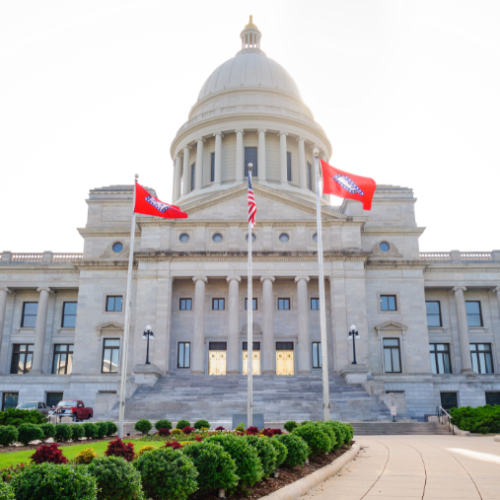In state-of-the-state addresses across the country this year, governors noted significant improvements to their states’ criminal justice systems. No longer solely focused on imposing tougher penalties for all crimes, states are increasingly making efforts to strengthen community supervision and use prison space for the most serious offenders. Whether addressing youth involvement in the criminal justice system, treating the behavioral health needs of people under correctional supervision or conducting a wholesale review of their state’s criminal justice systems, state policymakers are engaging in the important work that gets results.
Justice Reinvestment
Justice reinvestment is a data-driven approach to reduce corrections spending and reinvest savings in strategies that can reduce recidivism and increase public safety. Facing a projected prison population increase of 24 percent by 2018, West Virginia leaders employed justice reinvestment to slow the expected growth and bolster public safety. In May 2013, Gov. Earl Ray Tomblin signed justice reinvestment legislation into law that is projected to help the state avert $287 million in construction and operating costs. Taking the opportunity to highlight the achievements since enacting the legislation, Gov. Tomblin said:
“Last spring we began to improve public safety and reduce prison overcrowding by passing the Justice Reinvestment Act with bipartisan support. Since that time, my administration has rolled up its sleeves to begin implementing these reforms to build a foundation that will—over time—transform the landscape of our criminal justice system for the better. I am especially proud of our administration for developing innovative, collaborative solutions that will help former inmates recover from substance abuse find a job, and be productive members of society….Since June we have reduced overcrowding in our regional jails by more than 600 individuals. We have also reduced the overall number of corrections inmates—for the first time in 16 years—by almost 300 individuals. Now, through our justice reinvestment efforts, we are moving our inmates out of regional jails and into placements offering substance abuse and job training services.”
In May 2012, Georgia policymakers enacted justice reinvestment legislation that expands sentencing and probation sanctions options, relieves jail overcrowding, and improves statewide performance measurement. In talking about the progress his state has made in implementing the legislation, Governor Nathan Deal said:
“Over the past two years, we have found ways to reduce the need to build new prison beds, whereby we will save taxpayers hundreds of millions of dollars and keep Georgians safer—in 2012 with our Criminal Justice Reform and again in 2013 with our Juvenile Justice Reform, both of which passed unanimously in this General Assembly! These reforms gave us a blueprint on how to use rehabilitation to reduce recidivism. Already we have seen relief for taxpayer dollars by dropping jail backlogs by nearly 90 percent of what they were when I came into office.”
Confronted with a growing prison population projected to cost the state $224 million over the next decade, South Dakota policymakers sought to address the underlying factors contributing to those increases. In 2013, Gov. Dennis Dauggard signed justice reinvestment legislation designed to strengthen supervision, focus prison space on violent and repeat offenders, and ensure the quality and sustainability of reforms. In his state of the state address, Gov. Dauggard said, “Nearly two years ago, our state embarked upon a review of the state’s criminal justice system. The Chief Justice, legislative leadership, and I formed a work group to study our prison population and corrections system using a data-driven approach. We charged the work group with three clear goals: improve public safety, hold offenders accountable, and save money. The work group recommended and the legislature passed, last session, an extensive reform of our system—the Public Safety Improvement Act. These reforms included measures to strengthen offender accountability, offender supervision, ensure sustainability of the reforms, and focus prison space on violent and career criminals.”
Behavioral Health
Touting drug courts, first-responder training and expanded access to treatment, state leaders highlighted efforts they are making to enhance interventions for individuals with behavioral health needs who are involved with the criminal justice system.
Tennessee Gov. Bill Haslam
“Through our 41 drug courts across the state, we are working to treat substance abusers that want help in a way that is more productive than simply putting them behind bars and looking the other way. Our proposed budget includes funding for a new statewide residential drug court in Middle Tennessee.”
Mississippi Gov. Phil Bryant
“I have long been an advocate of drug courts, and I hope you will follow the guidance in my budget and fully fund this effort. These courts work. They provide a valuable service that helps get Mississippians on the right path again.”
Missouri Gov. Jay Nixon
“We added new mental health liaisons at each of our 29 community mental health centers, so that our law enforcement officers can focus on being cops, not frontline caregivers. We launched seven targeted emergency room response teams, to ease the burden on our doctors and nurses. And we made a historic investment in Mental Health First Aid training, so that more teachers, clergy, first responders, and ordinary citizens can identify the signs of mental illness and know what to do. Together, we are training more than 1,000 Missourians on these proven, life-saving techniques. And with your help this session, we’ll train thousands more.”
Vermont Gov. Peter Shumlin
“We have to figure out how to spend taxpayer money more wisely, while we treat the disease more effectively. We have made some headway. We have opened treatment centers in nearly every region of our state, considered to be national models. Thanks to your good work last year, we have expanded our efforts to combat Oxycontin and prescription drug abuse and to offer safe harbor to those reporting overdoses. We have lessened the penalties for small amounts of marijuana, acknowledging that we can better use our limited resources. Through a partnership between the Vermont State Police, the state drug task force, our state’s attorneys, local police, the federal government, and our Attorney General Bill Sorrell, we are getting tougher, using drug busts to disrupt dealer networks that kill our neighbors and kids.”
Youth
Several state leaders talked about youth involvement in the justice system, advocating for most teenagers to be adjudicated in the juvenile justice system and to provide youth reentry services.
New York Gov. Andrew Cuomo
“Our juvenile justice laws are outdated. Under New York State law, 16- and 17-year-olds can be tried and charged as adults. Only one other state in the nation does that; it’s the state of North Carolina. It’s not right, it’s not fair—we must raise the age. Let’s form a commission on youth public safety and justice and let’s get it done this year.”
Delaware Gov. Jack Markell
“Of 184 kids in custody at our Faulkland Road campus last year, only 11 were back in traditional schools six months later. Many kids drop out, are expelled, or are reincarcerated. This is our failure. We have seen the progress many of them make while under our care, and we must do better when they transition away from our facilities.
“I am asking you to fund community-based advocates to work with these families and kids after they leave the custody of the Kids Department. A 15-year-old doesn’t know how to access mental health services, reenroll in school, and get on a path to success. These advocates can make that happen. We also need to break the cycle of incarceration by getting these kids back into school.”
Arkansas policymakers have long expressed concerns about the state’s high recidivism rate. Over the past 10 years, an…
Read MoreIn April 2025, Arkansas Governor Sarah Huckabee Sanders signed a package of bipartisan criminal justice legislation into law,…
Read More Explainer: Key Findings and Options from Arkansas’s Justice Reinvestment Initiative
Explainer: Key Findings and Options from Arkansas’s Justice Reinvestment Initiative
Arkansas policymakers have long expressed concerns about the state’s high recidivism rate. Over the past 10 years, an estimated 72 percent of prison admissions in the state involved people who were revoked from supervision, with unmet substance use and mental health challenges playing a significant role in these failures.
Read More Explainer: How a New Law in Arkansas Tackles Crime, Recidivism, and Community Supervision Challenges
Explainer: How a New Law in Arkansas Tackles Crime, Recidivism, and Community Supervision Challenges
In April 2025, Arkansas Governor Sarah Huckabee Sanders signed a package of bipartisan criminal justice legislation into law, which is designed to increase public safety and improve community supervision. The legislation passed nearly unanimously.
Read More









